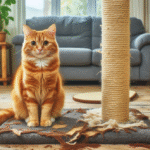Introduction to Pet Affection
Understanding pet affection is crucial for any pet owner seeking to strengthen their bond with their furry friends. Pets, whether they are dogs, cats, or other animals, have unique ways of expressing love and attachment to their humans. These signs may not always be overt or easily recognizable, but they are often present in everyday interactions. Recognizing these signs your pet secretly loves you (number 5 will shock you!) can significantly enhance the relationship and provide insight into their emotional states.

Pets express their affection in ways that are often instinctual, creating a language of love based on behavior rather than words. For example, a wagging tail or a soft purring sound can be indicators of happiness and contentment. Moreover, some pets may follow their owners around the house, showcasing a desire to be close and involved in their activities. These behaviors can be interpreted as strong signs that your pet values your company and cares deeply about you.
In addition to physical manifestations of affection, pets might also display love through more subtle gestures. These can include gentle nudges, soft eye contact, or even the act of bringing their favorite toy to you as a way of sharing and bonding. Each of these actions conveys a sense of trust and attachment, reinforcing the idea that pets have complex emotional lives similar to those of humans. By understanding these signs, pet owners can better respond to their animal companions, fostering a deeper connection.
As we delve further into the various signs your pet secretly loves you, it is essential to remain attentive and observant. Each sign offers a glimpse into the affectionate world of pets and unveils the profound bond shared between them and their owners. Throughout this exploration, you may even discover unexpected behaviors that highlight the depth of your pet’s love for you.
The Science Behind Animal Emotions

Understanding animal emotions has gained significant ground in recent years, equipped with advancements in research methodologies that enable a closer examination of how pets perceive love and affection. Scientific studies reveal that many pets, particularly dogs and cats, possess complex emotional responses similar to humans. For instance, researchers have identified that dogs experience a biochemical reaction to human interaction that mirrors the surge of oxytocin—often referred to as the ‘love hormone’—seen in human bonds. This indicates that dogs may genuinely develop love towards their owners, exhibiting signs your pet secretly loves you.
Furthermore, studies analyzing pet behaviors have uncovered numerous ways that animals express their feelings. For example, a study conducted at the University of California, Berkeley, demonstrated that dogs can recognize human emotional expressions. When faced with their owner’s happy or sad facial cues, dogs tend to react in ways that suggest empathy, such as approaching or cuddling their owners. These findings highlight that pets possess a profound emotional landscape and have the capacity to form deep attachments with their human companions.
Moreover, cats also display emotional depth—though their expressions of love may be more subtle than those of dogs. Research conducted at the University of Edinburgh has shown that cats may exhibit behaviors such as head-butting, purring, and kneading to show affection. This indicates that their emotional ties to humans run deep, affirming the signs your pet secretly loves you are indeed based on genuine emotional expression.
Additionally, neuroimaging studies have explored how pets interpret social cues and how their brains respond to interactions with humans. This research has provided compelling evidence that animals are not only capable of emotional responses but can also actively engage in relationships characterized by mutual affection. The implications of these findings extend beyond mere observation, offering a scientific basis for understanding the emotional bonds we share with our pets.
Tail Wagging and Body Language

One of the most recognizable signs your pet secretly loves you is through their tail wagging and overall body language. Dogs, in particular, utilize their tails as a primary means of communication. A wagging tail, especially when coupled with an open, relaxed posture, typically indicates happiness and affection. If your dog greets you with a wagging tail and a body that seems loose and agile, it is a clear sign of their enthusiasm and contentment in your presence.
Additionally, closely observing your dog’s body language can provide insights into their emotional state. For instance, an excited dog may jump and circle you, showcasing an eagerness to engage. On the other hand, a lower wag or neutral tail position could indicate a more passive affection, suggesting that they feel secure and comfortable around you. Cats, although they communicate differently, also exhibit signs of love through their body language. A cat that approaches you with a held-up tail and a slight twitch at the tip is expressing affection and readiness to connect.
Facial expressions in both dogs and cats can further reinforce these signs. Dogs often display a relaxed mouth, bright eyes, and a soft gaze when they are happy. Similarly, cats might blink slowly at you—a behavior often referred to as “cat kisses,” which signifies trust and affection. Understanding these nuanced body language signals is essential for recognizing the love your pet has for you. By paying attention to how your pet expresses themselves physically, you can gain insight into the depth of their affection, confirming the many signs your pet secretly loves you. In fact, being attuned to these cues will only enhance the bond you share with your beloved animal companion.
Sign #2: Following You Everywhere

One of the most noticeable signs your pet secretly loves you is their constant tendency to follow you around. Whether you are moving from room to room or simply taking a stroll around the house, you may find your furry companion trailing closely behind you. This behavior is not just a quirk; it is deeply rooted in their instincts and emotional attachment to you.
Pets, particularly dogs and cats, are inherently social animals. Their desire to stay close to their human companions stems from their need for companionship. Dogs, in particular, are pack animals, which means they thrive in social structures. When they follow you around, they are not only seeking to be close to you, but they are also expressing their affection and loyalty. They feel secure in your presence and want to be part of whatever activity you are engaged in, reinforcing the bond between you and your pet.
Moreover, this behavior can also signify that your pet is looking out for you or has a protective instinct. Many pets develop a heightened awareness of their surroundings, especially when they perceive potential threats. By staying close to you, they can monitor the environment and ensure your safety. This sense of protection can be seen as a profound expression of love and dedication, as they prioritize your well-being over their own comfort.
In addition to companionship and protection, your pet may follow you around seeking attention or affirmation. If your pet is particularly active around you, it could indicate they are eager to engage in play or receive affection. Not only is this a sign of their love, but it also provides an opportunity for emotional bonding between you and your pet. Overall, this behavior clearly illustrates that following you everywhere is indeed one of the unmistakable signs your pet secretly loves you.
Sign #3: Bringing You ‘Gifts’
One of the most endearing signs your pet secretly loves you is their tendency to bring you ‘gifts.’ This behavior, observed commonly in both dogs and cats, often manifests in the form of toys, items they find around the house, or in some cases, even prey. While this may seem puzzling at first, it is rooted in their natural instincts and affectionate behavior toward their owners.
For dogs, the act of presenting you with a toy can be viewed as an offering in an attempt to share their joys with you. This is an extension of their sociable nature, which drives them to seek approval and validation from their human companions. By bringing you their cherished items, they are essentially showing that they trust you and want to include you in their playtime and daily activities.
Cats, on the other hand, exhibit this behavior differently. When a cat brings you a mouse, bird, or even an unusual found item, it may seem alarming at first. However, this is a natural instinct that signifies affection and an acknowledgment of your role as part of their family. In the wild, a mother cat brings back prey to teach her kittens how to hunt and survive. By mimicking this behavior with their owners, cats indicate that they view you as one of their own and wish to share their accomplishments with you.
Understanding these ‘gift-giving’ behaviors can foster a deeper bond between you and your pet. Consciously recognizing the signs your pet secretly loves you, such as when they present you with these items, enhances the emotional connection you share. In conclusion, these gestures from your furry companions are more than simple behaviors; they are heartfelt expressions of love and trust. Recognizing them can lead to a richer relationship built on mutual affection and understanding.
Sign #4: Purring, Meowing, or Other Vocalizations

The vocalizations of pets often serve as an emotional barometer for their feelings, allowing pet owners to discern the affection their companions may hold for them. In particular, the sounds emitted by cats and dogs can be indicative of their love and attachment. For instance, when a cat purrs softly, it is frequently a sign of contentment and trust, often directed towards their human companions. This gentle, rhythmic sound can signify that the cat feels safe and secure in your presence, essentially making it one of the key signs your pet secretly loves you.
Moreover, cats may also create a series of chirps and trills that can be interpreted as a form of communication, especially when they are seeking attention or affection from their owners. These playful and affectionate sounds are unique to felines and can indicate a strong bond between the pet and their human, further supporting the notion that vocalizations are a direct expression of love and companionship.
On the other hand, dogs utilize a variety of vocalizations to express their feelings. Happy barking is one of the most clear signs of a dog’s affection. When dogs bark with excitement—often accompanied by a wagging tail and playful demeanor—they express joy and enthusiasm in the presence of their beloved owners. Additionally, soft whining can also signify a desire for closeness or affection, showcasing their need for interaction. These vocal cues, whether it’s the purring of a cat or the joyful barks of a dog, underscore the deep emotional connections that pets form with their humans, ultimately reflecting the love they harbor.
Sign #5: Grooming and Nuzzling – The Shocking Truth
One of the most compelling signs your pet secretly loves you (number 5 will shock you!) is their grooming and nuzzling behavior. While we often perceive grooming as a mere hygiene activity, it carries significant social implications in the animal kingdom. Pets, particularly dogs and cats, engage in grooming not only to keep themselves clean but also to strengthen their bonds with their human family members.
When your pet licks you or attempts to groom you, it is an instinctual behavior rooted in their ancestral practices. In the wild, animals groom each other to show affection, reinforce social hierarchies, and promote group cohesion. This is a fundamental part of their social structure, and when your pet performs this act on you, they are expressing their love and affection. Essentially, they are treating you as part of their family or ‘pack.’ It is a natural extension of their comfort and closeness with you.
Nuzzling, on the other hand, is another affectionate behavior indicating that your pet regards you with love. When your furry friend nudges you with their nose or snuggles into your side, it is not just a search for physical warmth; it symbolizes trust and emotional connection. This intimate action showcases their desire for closeness and reveals how they value being near you.
These behaviors are vital indicators of your pet’s emotional state. When they groom and nuzzle, they convey their contentment and belonging. Thus, recognizing these signs your pet secretly loves you can deepen your understanding of your relationship. The affectionate gestures, framed within the context of grooming and nuzzling, highlight a shared bond that transcends mere companionship.
Understanding Personal Space Behavior
The intricacies of personal space can reveal much about the relationship between pets and their owners. Understanding how pets interact with their personal space offers insights into their affection and emotional state. For instance, a pet that frequently seeks closeness and enjoys cuddling is often displaying clear signs your pet secretly loves you (number 5 will shock you!). This behavior signifies trust and comfort, indicating that your pet feels safe enough to invade your personal space willingly.
Conversely, some pets may be less inclined to snuggle but still express their love in more subtle ways. For example, a cat may sit nearby without seeking direct contact, while a dog might stay within a close yet respectful radius. This behavior suggests that the pet appreciates your company, demonstrating attachment and love, albeit in a manner that honors their need for space. Recognizing these signs is important for understanding your pet’s unique personality and their way of showing affection.
Additionally, the variation in personal space preferences among different species and individual pets warrants consideration. Dogs, typically more social and pack-oriented, may be more prone to closeness compared to cats, which often value their autonomy. Nevertheless, both behavior patterns can signify love. Analyzing how your pet adjusts their distance during interactions can lead to a better understanding of the signs your pet secretly loves you (number 5 will shock you!). Moreover, when a pet chooses to stay near you, even without physical contact, it reflects a deep emotional bond, showcasing that love can be expressed in diverse ways.
In conclusion, whether through cuddles or maintaining a respectful distance, the way your pet navigates personal space serves as a significant indicator of their affection towards you. Recognizing these signs helps strengthen the bond between you and your beloved companion.
Recognizing Signs of Affection in Different Pets
Understanding the signs your pet secretly loves you is crucial for forging a deeper bond with your furry, feathery, or scaly friends. Each species has its unique way of expressing affection, making it essential to pay attention to specific behaviors that reflect their love. For instance, dogs are generally quite overt in their affection; they may wag their tails vigorously, bring you their favorite toys, or follow you from room to room. These actions are clear indicators of attachment and loyalty, showcasing that your pet holds you in high regard.
Cats, on the other hand, tend to exhibit a subtler form of affection. A cat that head-butts you, kneads your lap, or purrs contentedly while resting near you is revealing signs of trust and love. This behavior indicates that your cat feels safe in your presence and enjoys your company. Additionally, slow blinking, often termed “cat kisses,” is another sign that your feline friend genuinely loves you, as they use this gesture to express comfort and affection.
Rabbits, while less traditional in their display of affection, offer their love in unique ways. If your rabbit follows you around, nudges you with its nose, or performs a joyful binky, these are all signs your pet secretly loves you. This small creature’s affection can also be demonstrated through grooming behavior, as rabbits will often lick their owners to show they care.
Birds, too, have their ways of expressing love. A bird that sings or talks more frequently around you, preens your hair, or nuzzles against you is likely demonstrating its affection. Understanding these various signs can enhance your relationship with your pet, making the bond between species one of mutual love and respect.
Conclusion: Strengthening Your Bond
In reflecting on the signs your pet secretly loves you (number 5 will shock you!), it is evident that understanding these behaviors can significantly enhance the relationship between you and your furry companion. Your pet’s affectionate actions, such as following you around, bringing you their favorite toys, or even the simple act of cuddling can be indicative of a much deeper bond. These signs are not merely instinctive behaviors; they are expressions of love and loyalty that contribute to your pet’s overall happiness and well-being.
Recognizing these subtle signs is crucial for pet owners as it allows for a more profound understanding of their animal’s emotional state. Building a strong bond requires mutual recognition and respect for each other’s needs. Therefore, being attentive to your pet’s behavioral cues can lead you to discover what makes them feel loved and secure. Activities like spending quality time together, engaging in play, or even just being present in the same space can solidify this attachment.
Moreover, nurturing the emotional connection is essential for the psychological well-being of both pets and their owners. A pet that feels loved and understood is generally more content, which in turn can lead to better behavior and health. Conversely, owners who share a loving relationship with their pets often experience lower stress levels and emotional fulfillment. Consequently, it is beneficial to regularly observe your pet and appreciate the signs of their affection.
Ultimately, every moment spent nurturing this bond pays dividends. Paying attention to the signs your pet secretly loves you will not only strengthen your connection but also enrich both your lives in ways that go beyond mere companionship.






